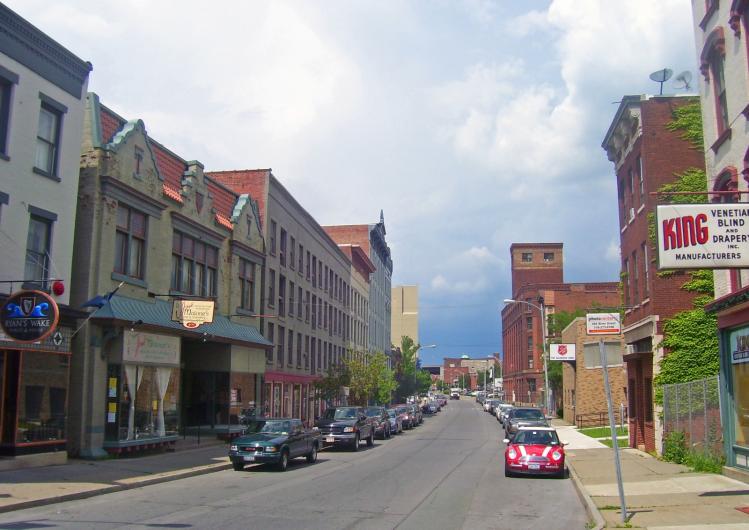
I grew up in Greenwood, South Carolina, a small mill town with a population of around twenty thousand. Like many Southern towns, much of it is centered around a large Walmart and some small family-owned restaurants. Further uptown lies the mill, which is still around, though fewer residents work there compared to its peak decades ago and operations have downsized considerably. As a result, until recently, there had been a surplus of unused old red-brick buildings. But, seemingly overnight, these buildings are now occupied. There is an axe-throwing bar and a brick-oven pizzeria. There are a couple of upscale bars where the Chamber of Commerce holds events staffed by bearded guys with tattoo sleeves. And there are even a few luxury apartment complexes whose units, absurdly, rent for more than my old apartment back in Washington D.C. What’s going on here?
Fortunately, there’s someone able to explain these changes going on not only in my hometown but in similar small cities across the nation: David A. Banks, director of globalization studies at the University at Albany, who recently published The City Authentic: How the Attention Economy Builds Urban America. In the book, Banks documents how and why, in the aftermath of the Great Recession, cities are rebranding and rebuilding themselves along the lines of an “authentic” urban experience.
The trend towards what Banks calls the “City Authentic” is the result of “the search for meaning in cities’ amenities and landscapes within today’s attention economy” and “begets a cynical, postmodern tapestry of symbols, brands and algorithmically selected aesthetic motifs that are anything but unique or beautiful.” These cities end up becoming caricatures of themselves: bars’ decor imitates whatever long-defunct industry once occupied the premises and summer festivals romanticize the city’s past by pushing twee merchandise to new transplants.
Banks divides the history of urban America into three rough stages: preceding the City Authentic are the “City Beautiful” and the “City Efficient.” The City Beautiful emerged in the mid-to-late-nineteenth century and is defined by its propensity towards “grand construction projects that signaled [the United States’] arrival on the world stage.” The country’s urban upper class burst out of the highly profitable Civil War and sought to channel their wealth into epic architectural projects such as museums and opera houses.
Gradually, however, concern shifted toward creating a more effective and standardized environment for capital accumulation. Bigger and more beautiful was not necessarily better. Around the early-to-mid-twentieth century, the City Efficient coalesced, seeking more controlled growth. “[D]owntowns were bulldozed in urban renewal programs that sought to increase car infrastructure and build according to the modernist architectural ethos of form follows function.” Cities attracted capital by making investment more predictable through better infrastructure. Think, for example, of Robert Moses’s parkways and bridges in New York, and the 1963 demolition of the old Penn Station. Of course, most of these projects were not benign. Under the dubious rationale of “slum clearance,” many of the massive highways of the period were built through Black neighborhoods such as middle-class Sugar Hill in Los Angeles (the Santa Monica Freeway), Overtown in Miami (I-95), and Rondo in St. Paul (I-94).
For Banks, recent small-city development represents another sea change in the conception and audience of the city. The City Authentic presents itself as a kind of influencer’s playground. It has amenities with Instagram-ready historical flourishes: there are abandoned brick buildings with the veneer of something old and worn—something authentic. This and the relatively lower rents compared to those of the major metro areas pull in younger residents.
One of the best parts of Banks’s book is his case study of Troy in upstate New York, an archetypical post-industrial city. The once-booming iron, steel, and textile industries had left by the middle of the twentieth century. When Banks moved to Troy in his early twenties, it was “a sleepy place with a few good bars” and low cost of living. But then, during the Great Recession, the entire town rebranded to grab outsiders’ attention. Wine bars began opening up, catering to businesspeople and young professionals fleeing New York City’s sky-high rents. Troy, as Banks puts it, transformed itself into a “museum of its own past.”
Take Bradley’s Tavern, which was renamed as The Bradley when Clark House Hospitality bought it. Under new ownership, it “underwent a subtle transformation from a dive bar to a dive-bar-themed bar.” For Banks, this is a typical example of how Authenticity works. Each previous owner of the bar had renamed it after either the owner or the target customers (before Gary Bradley bought it in 1990 the bar was named College Inn because it served college students). But Clark House, the latest owner, was the first “to name the bar after something in the past rather than the present.” Banks writes, “Going from Bradley’s Tavern to The Bradley shows how places, people, and things of the past go from active to static—from a real-life person possessing the tavern you frequent to a place that is interesting because it used to be a place like that.”
I was struck by this particular example because an identical process—of appropriating the past, packaging it for consumption, and using it as a means of grabbing the attention of developers, tourists, and businesspeople—has been unfolding in Greenwood for more than a decade. Since the Great Recession, Greenville—a city an hour north of Greenwood and the Upstate’s biggest population center—has experienced a rapid uptick as Northerners move in to exploit the cheap cost of living, low taxes, and beautiful mountains. All across the Upstate, developers and local elites in towns like Greenwood have been rebranding themselves to try to cash in on Greenville’s surge.
The red-brick buildings of uptown Greenwood are now sites of Authenticity where young professionals can come hang out, grab a beer, and post about their experience on Instagram. A prime example is the Mill House, the brick-oven pizza restaurant which first started out of the owners’ backyard. During the Great Recession they leveraged the collapsing real estate market and in 2009, the Mill House had its grand opening in a commercial building. Like The Bradley in Troy, the Mill House leverages Greenwood’s past as an important site of textile production in the Upstate. Though the Mill House’s owners are nice and the pizza’s pretty good, there’s something artificial about uptown Greenwood’s drive towards the City Authentic.
Despite the growing number of amenities, Greenwood itself hasn’t grown very much. The town’s population has only increased by around a quarter of a percent since 2010—nothing next to Greenville’s 16 percent. And the people don’t seem to be thriving. They are earning the same low wages they were before but paying higher rents for the high-end amenities that have been tacked on to a stagnant mill town.
Who are the people moving in? Just like the New York City professionals who moved to Troy, the Northerners moving to Greenville are pushing out those who’ve lived there for years. Now, Greenville natives are looking for housing beyond the county’s borders, as are the professional latecomers to the Upstate boom who are being pushed out of Greenville itself. Hence the luxury apartment complexes being built out of the post-industrial half-life of my hometown. Greenwood’s Authenticity is an echo of Greenville’s.
The second part of Banks’s book excels in grappling with this phenomenon. There he seeks to answer the question many Rust Belt inhabitants are asking: “Why are they building all this new stuff when what we have now is falling apart?” Banks bases his analysis on sociologist Harvey Molotch’s idea of the “Growth Machine,” which posits that civic elites seek above all to commodify the city so that they can benefit from future land-derived profits. Growth, according to their rhetoric, is good for everyone: it brings jobs, tax revenue, and development. It means more pie so that everyone—theoretically even the most marginalized—can get a slice.
But, in small post-industrial towns like Greenwood, desperate for any revenue to compensate for their shrinking tax base, these local leaders find themselves in a lose-lose situation. Because each jurisdiction is competing for investment, a race to the bottom ensues. Local elites are pressured to accept bad deals because if they don’t, their neighbors will. And of course, as Banks observes, “City leaders and their staff…lack the experience and know-how to go toe-to-toe with a legal team whose legal department likely dwarfs most cities’ entire budget.” So, a vicious cycle ensues: local leaders lower taxes, cater to developers, and transform their cities into playgrounds for capital while those unlucky enough not to own property are left out to dry. Cities on the margins are in a race to see who can hollow themselves out the quickest.
The Rust Belt is indeed undergoing revitalization of sorts. Towns like Peoria, Milwaukee, and Cincinnati are doing their very best to attract capital to their once-decaying downtowns. City councils are hiring PR and consulting firms to package and sell their municipal histories on social media and to attract high-earning professionals and businesspeople. They give wannabe Silicon Valley start-ups huge tax breaks and free space in abandoned warehouses and factories despite the fact that they bring very few jobs to the area.
In the process, rents are rising—22 percent in the Albany metropolitan area from 2010 to 2019—but city services aren’t improving. Banks recounts how, in 2022, during the pandemic, Troy’s main utility company, National Grid, was going to shut off the electricity for thousands of Troy customers because of maintenance issues. But the city’s website didn’t have any information about it, only displaying marketing headlines like “City of Troy Architecture, Streetscapes Featured on HBO’s ‘The Gilded Age.’” Banks casts new light on the social-media savvy of the Authentic red-brick aesthetic recognizable on these towns’ Instagram and Facebook feeds. By linking these marketing campaigns to the global economy, Banks demystifies the so-called “influencer economy” of the 2010s and 2020s and situates it in the industrial and post-industrial cycles of capitalist accumulation.
Banks argues that a form of democratic socialism is the only way to fight these laws of accumulation. Plucky technocrats have enabled rather than hampered “structures of power”—from Chambers of Commerce to city councils—built to enfranchise the propertied and disenfranchise the propertyless. While competing interest groups fight for capital in the short run, cities become less livable in the long run as more resources are invested in attracting capital at the expense of citizens’ well-being. A politics that overcomes the anarchic tyranny of capital, Banks contends, can only be forged out of solidarity, overcoming geographic divisions and uniting the office worker and factory worker, black and white, man and woman. Disrupting capital’s game of pitting one city against another requires replacing the rule of the grasstops with that of the grassroots—mass democracy.
The last time I visited home I talked with one of my best childhood friends about the paradoxes of Greenwood. It’s strange how our hometown is getting more expensive, we said to each other, how people have been told by the provincial elites that Greenwood is about to boom economically, yet the town has received little of the manna from heaven it was promised. Then, we talked about all our friends from high school who have moved away to find better jobs and escape high rents. The axe-throwing bars came in and displaced my friends. Once capital leaves Greenwood as quickly as it arrived, where will it—and the axe-throwing bars—go next?
The City Authentic
How the Attention Economy Builds Urban America
David A. Banks
University of California Press
$26.95 | 224 pp.
Please email comments to [email protected] and join the conversation on our Facebook page.
Previous Story
The Poet Laureate of Losers
Next Story
Putting Security First


